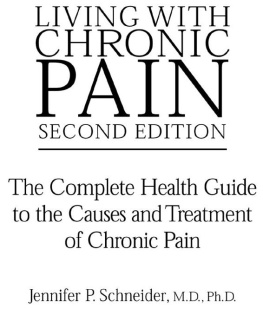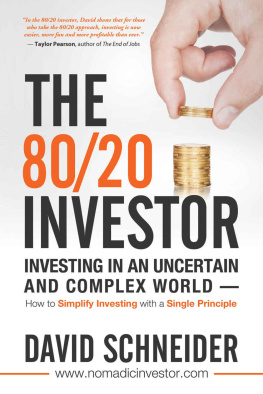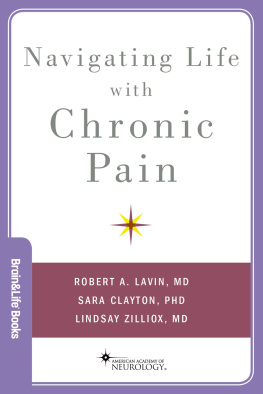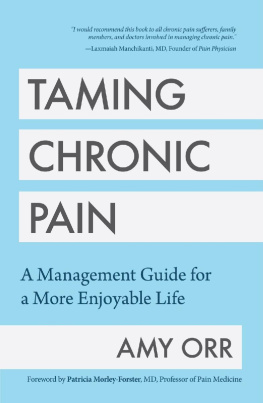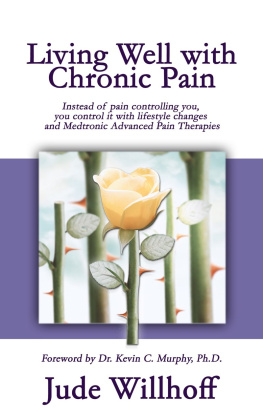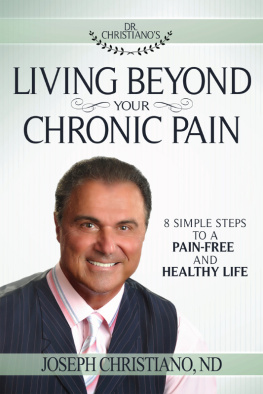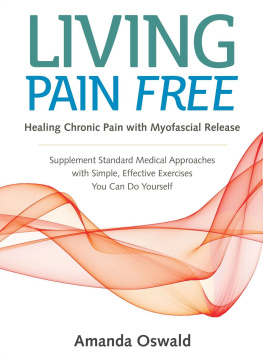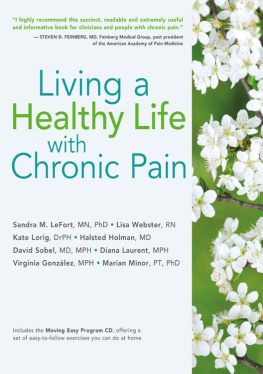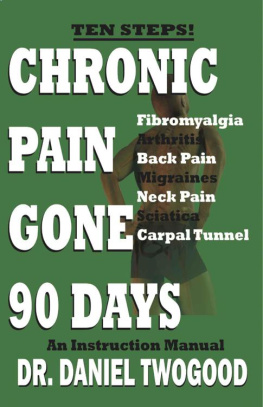D EDICATION
T O MY DAUGHTER , Jessica Grace Wing, 1971-2003.
Cancer brought her pain and suffering
Yet she lived her life fully until the end
Death freed her
She will always be with me in spirit.
Her music will keep her alive in the hearts of many.
T O MY SON , Benjamin Patai Wing,
He showed me up close that chronic pain can take away a persons life and that good pain management can restore it.
CONTENTS

PREFACE
Why Another Book on Chronic Pain?
PART I:
1: INTRODUCTION TO CHRONIC PAIN
What It Is
2: THE CAUSES OF CHRONIC PAIN
Why It Happens
3: DECIDING ON A DOCTOR
Working with the Specialist of Your Choice
PART II:
4: AN INTRODUCTION TO MEDICATIONS
Their Uses and Side Effects
5: OPIOIDS
What They Are and When They Are Useful
6: ADDICTION OR PHYSICAL DEPENDENCY?
The Truth Behind the Terms
7: GETTING INSIDE YOUR SKIN
Invasive Procedures
8: DEALING WITH PAIN DURING SURGERY
When to Use Pre-emptive Pain Relief
9: EXERCISE, PHYSICAL THERAPY, AND OTHER HANDS-ON APPROACHES
Do They Work?
10: COMPLEMENTARY AND ALTERNATIVE TREATMENTS
A Second Health Care System
11: ENGAGING THE MIND
A Mind-Body Approach
PART III:
12: THE ENNEAGRAM PERSONALITY TYPES
What Type Am I?
13: HOW PERSONALITY TYPES COPE WITH PAIN
Advice and Challenges
PART IV:
14: THE COSTS OF CHRONIC PAIN
Treatment and Insurance
15: TO THE FAMILY AND FRIENDS
How to Help
16: CURRENT RESEARCH AND TRENDS
New Developments in Surgery, Postoperative Analgesia, and Opioids
P REFACE
Why Another Book
on Chronic Pain?
Dr. Richard A. Gardner, a [noted] psychiatrist and psychoanalyst died on May 25 at his home in Tenafly, NJ. He was 72. The cause was suicide, said Dr. Gardners son, Andrew, who said his father had been distraught over the advancing symptoms of reflex sympathetic dystrophy, a painful neurological syndrome.
N EW Y ORK T IMES , J UNE 9, 2003, P .A29.
P ain can kill. Patients with chronic pain attempt suicide more often than people without pain, and they are two to three times more successful than suicide attempts in the general population. Some of these suicide attempts are caused by depression, which is very common in people with chronic pain. But others occur in people who are not clinically depressed but who simply are no longer able to tolerate their undertreated pain. What most people who request assistance to die really want is help in ending their pain.
Unfortunately, chronic pain, especially chronic pain unrelated to cancer, is notoriously undertreated. In 1999, the American Pain Society surveyed 805 people with chronic pain about the adequacy of treatment they received from their physicians. More than 50 percent of the survey respondents had been in pain for more than five years, and more than 40 percent of respondents with moderate to severe pain could not find adequate relief. For most sufferers, the cause was arthritis or back disorders. Almost half of the 805 patients had changed doctors at least once. The most common reasons were too much pain (42 percent), the perception that their last physician did not know a lot about pain management (31 percent), the belief that the doctor didnt take their pain seriously enough (29 percent) and the doctors unwillingness to treat their pain aggressively (27 percent). Only 26 percent of those respondents with very severe pain reported taking opioids (narcotics, the strongest painkillers available) at the time of the survey. Responding to the survey results, Dr. Russell Portenoy, a pioneer in treating cancer and non-cancer pain, said, This survey shows the stigma associated with opioid drugs. Although these drugs can clearly benefit some patients with chronic pain, patients, caregivers, and physicians overestimate the risks and fail to use the drugs appropriately.
Dr. Portenoy has been one of my heroes for many years, ever since I began learning about appropriate treatment of chronic pain. For many years I was an internal medicine physician, treating adults with diabetes, hypertension, heart disease, and other nonsurgical problems. I knew no more about treating pain than do most internists, which is to say I knew very little. But then a family problem led me to become interested in addiction medicine and that, in turn, led to requests by other primary care doctors to consult on their patients who kept asking for more pain medicine for their chronic pain. Please evaluate his drug-seeking behavior, they would request. So I began learning about treating chronic pain, about available medications and nondrug modalities, and about differentiating drug addicts from chronic pain patients. Eventually, I gave up primary care, and these days I limit my practice to pain management and addiction medicine. I also travel around the country giving talks to other health professionals on treating chronic pain. And, coincidentally, in the past few years both of my children have personally experienced chronic pain and its treatment, which made me more committed than ever to promote its better treatment.
A few years ago I decided to write about what I have learned. There are already hundreds of books on chronic pain available! So why did I decide to write another? Because despite the extensive number of books already out there, many questions are still unanswered and many subjects misunderstood.
One area in which this is particularly true is the role of opioids in the treatment of chronic pain. Morphine and its related drugs are the most powerful painkillers available, and they are now routinely prescribed to patients dying of cancer. But fear and lack of knowledge of these drugs prevent many doctors from prescribing them for people whose pain is caused by anything other than cancer. The War on Drugs, which has been waged unsuccessfully against drug dealers and addicts by the government of the United States, has spilled over into the practice of prescribing painkillers by physicians. The result is that even those physicians who might otherwise recommend painkillers for their suffering patients are hesitant because they fear risking their medical license. Although a few physicians have indeed been unfairly targeted, most doctors concerns are overinflated and unwarranted. Regulatory agencies and professional medical associations have issued guidelines to physicians regarding the appropriate prescribing of opioids for chronic pain. Physicians need only to be educated about these guidelines.
But educating doctors is not enough. An editorial titled When will adequate pain treatment be the norm? published in 1995 in the Journal of the American Medical Association (JAMA) explained,
Bringing about significant change may, in reality, depend on empowering patients to demand adequate pain treatment, regardless of what that treatment may require. If so, this empowerment will not come easily, especially if opioids [narcotics] must be used for pain relief and if the pain is of a nonmalignant origin.

